The Alchemy of Holding Change in The Nexus of Well-Being and Art
On grief beyond language, listening as an act of care, and how light, color, and scale evoke meaning and connection in an exhibition by Anne Labovitz at the Rochester Art Center
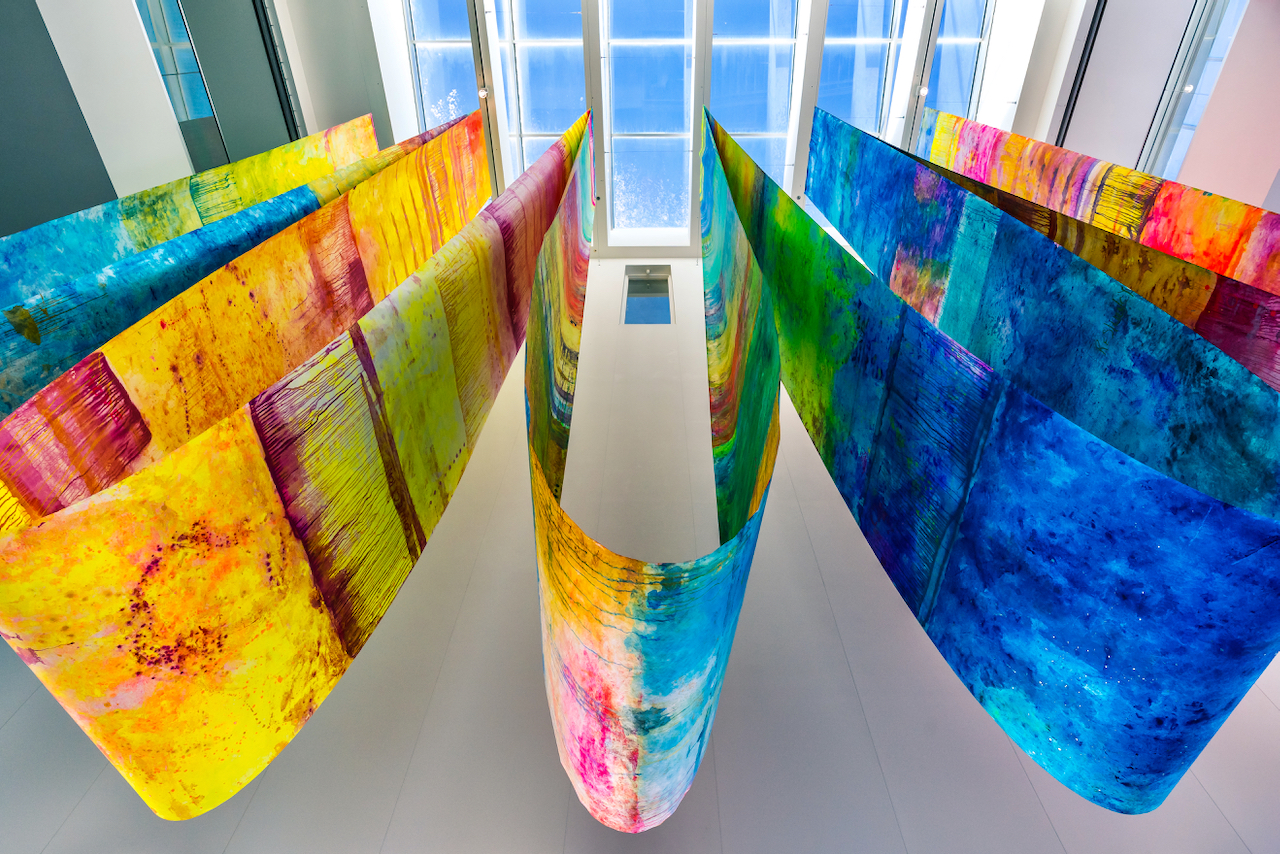
It is Saturday. A gallery wall is holding me up, bracing my back as the sounds of the gathering crowd float up into a soft faraway din that I am grateful to be away from. I am waiting for the dancers of Kalpulli Yaocenoxtli to dress and gather their ornate plumed headdresses, sacred drums, and conchas to open a community memorial for a dear friend. My eyes sting, my throat raw from tears I have kept at bay all morning. I think of running outside to the park behind the building, or to the banks of the Zumbro River that runs beside it, and screaming into the treetops, my echo sending dandelion seeds scattering to the wind. But I stay. Grateful for the wall behind me, the floor beneath keeping me upright. And then I see it, truly see it: the large installation draped with such deceptive lightness and ease. The colors drip, swirl, ascend—defying gravity and saturating the space with a quiet power and splendor. I feel the colors in my heart this time, and somewhere just above my belly button. I want to vault into the light-soaked atrium and swim in the colorscape. And for a moment, my spirit leaves me, achieving for just a second what my physical body cannot—greeting the copious yards of swooping material recognizing it as kindred. I consider the one word I can read from my vantage point painted into one of the folds: “hope.” I breathe it in for a moment. The “huh” in my throat, the “oh” lengthening my cheeks, the “peh” a fleeting kiss. I have seen this piece before, weeks ago. The artist herself walked me through her latest exhibition. But today…today, it is holding me in its care. Today, it is reaching out to me and I to it.
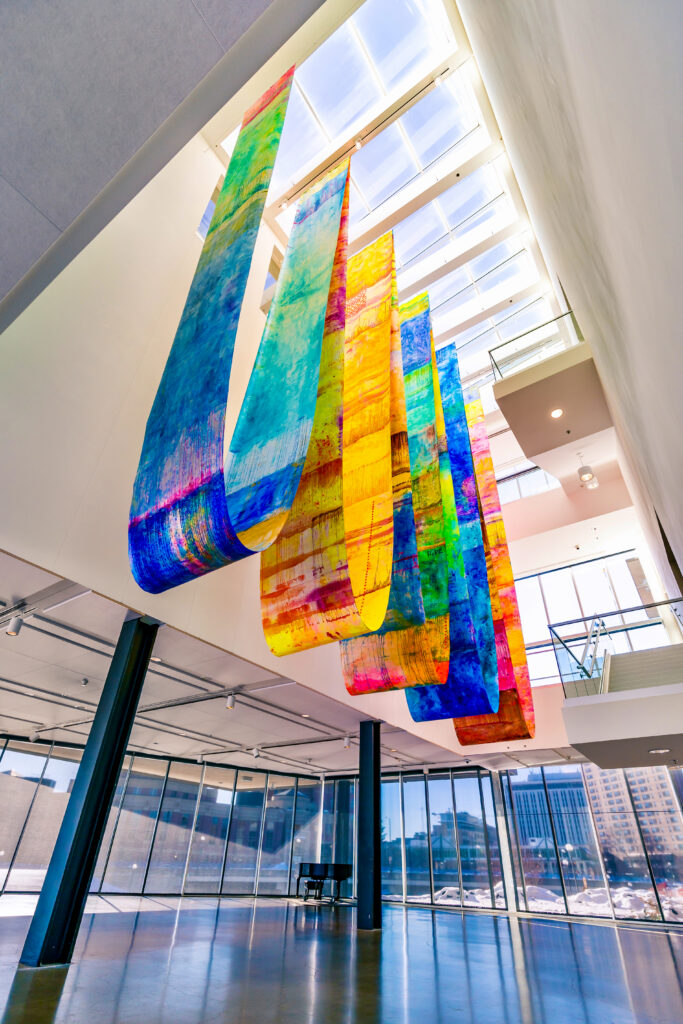
I find I cannot write about Anne Labovitz’s1 current exhibition, The Nexus of Well-Being and Art at the Rochester Art Center, without centering the way my season of change and grief—in the wake of a career change, as well as the recent deaths of a beloved friend and three extended family members in the span of a few short months—has shaped how I experienced the exhibition and connected with her work. The exhibition itself is not explicitly about grief. Yet, for the first time, I am beginning to wonder if all art is not inherently in conversation with grief, loss, and really, ultimately, change.

Anne Labovitz, Well-Being LightWindows I-III with lights on, 2023. Photo: Eric Mueller. 
Anne Labovitz, Well-Being LightWindows I-III with lights off, 2023. Photo: Eric Mueller. 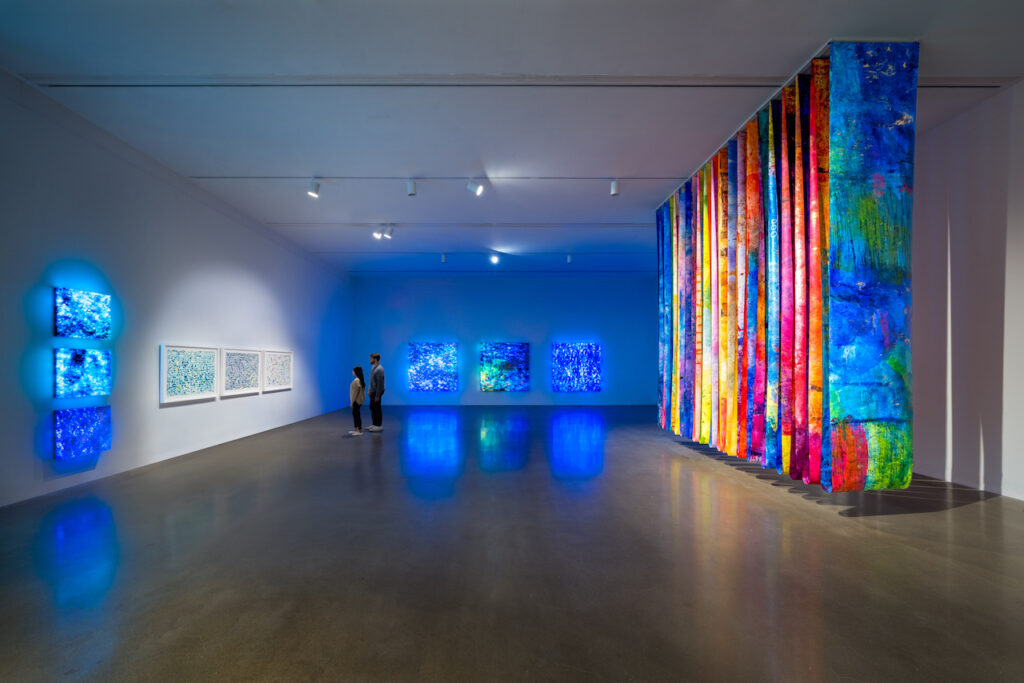
Anne Labovitz, The Nexus of Well-Being and Art, 2023. Photo: Eric Mueller.
Labovitz’s paintings embody the dynamics of change. In Well-Being LightWindows I-III, the backlit paintings create an illusion of movement and animation. The colors glow in a choreography of cobalt, chartreuse, and ultraviolet hues and then shift subtly like moonlight on the water. During our tour, Labovitz unplugged the 576 LED lights studding the acrylic vitrines behind the painted Tyvek®. The paintings changed again, and I stood before an almost entirely different work with soft metallic streaks and blue-green shadows still in motion. The unlit pieces stood with a sovereign, potent gravity that centered me as I stood before them. Their sudden density and depth gathering me up, pulling me together. While visitors to the exhibition are meant to see the paintings lit up, this glimpse behind the curtain highlights the deep intentionality in Labovitz’s practice and her intensive experiments in the evocative and transformative power of light, color, and scale. Indeed, the contrast between the lit and unlit paintings drive at the reality that there can be no light without darkness, no sense of meaning and life without the inevitability of death, loss, suffering. In Embracing Well-Being, lengths of Tyvek® hang from floor to ceiling, folded close together in deep, vibrant colors. Each fold sways gently in the gallery. As a whole, the effect is organic as if the entire piece is breathing, cultivating breath.
I have only recently begun learning how to breathe. How not to hold my breath for weeks, months, years at a time. breath connects. (i can’t breathe) (i am still breathing) breath moves.
Despite its towering scale, the installation is immersive, intimate, and enveloping, much like an embrace. The space around it seems to expand, and once again, my urge is to launch myself right into the piece. This urge to vault is a curious one, and one I’ve seldom felt when looking at art. I often lean in as far as permitted into a piece or an object. But they usually remain separate from me in some way, bordered up by real or imagined boundaries delineating where I and the object end and begin. In contrast, Labovitz’s pieces seem to soften these borders, the lines fluid, inviting movement toward and within. Embracing Well-Being’s tight accordion-like folds beckon, inviting wonder and wandering. In his essay for the exhibition catalog, Matthew Villar Miranda notes, “Labovitz’s insistence on scale and suspension allows the viewer to grasp the relationship between themselves and the artwork, in particular the notion that the work only attains meaning or “wholeness” when the viewer brings their own embodiment to bear upon it.”2
“Our bodies want to move together,” Labovitz states as she reflects on her use of color, scale, light, form, and movement, and the ways in which she uses them to mine for meaning and connection. For her, connection between people is just as important as any connection an individual feels to her work. The peculiar pulling sensation her work evokes in me seems to reflect a practice in leaning into one another, drawing close to one another, moving with one another. Her own expansive social practice is predicated on these moments of sharing space, connection, and care. The exhibition invites viewers to participate in their own installation by adding their personal responses to the prompt “What does well-being mean to you?” to a sprawling gallery wall. Small square stickers with the words hope, love, rest, peace, community, resilience, calm, purpose, connection, and wellness are offered to viewers throughout the exhibition as a gift from the artist.
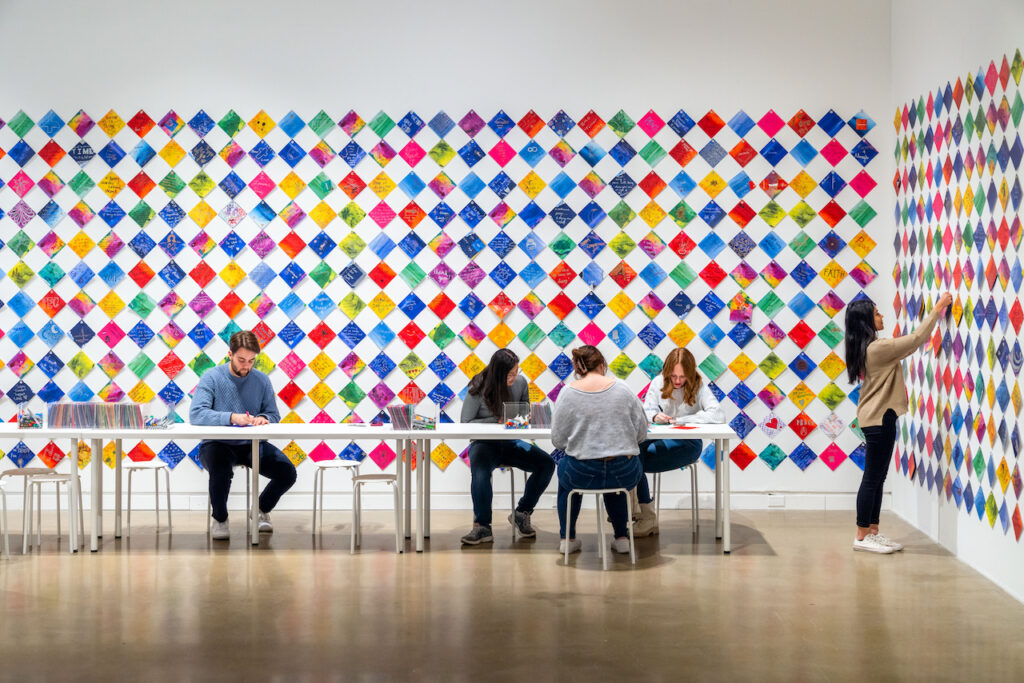
Anne Labovitz, Well-Being Wall, 2023. Photo: Eric Mueller. 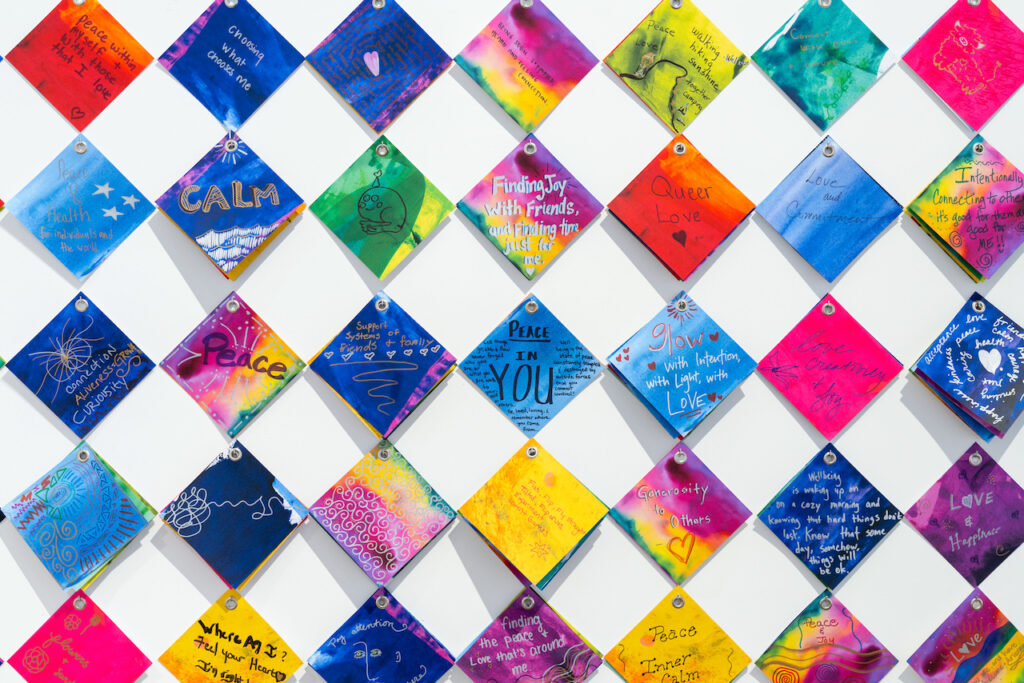
Anne Labovitz, Well-Being Wall, 2023. Photo: Eric Mueller. 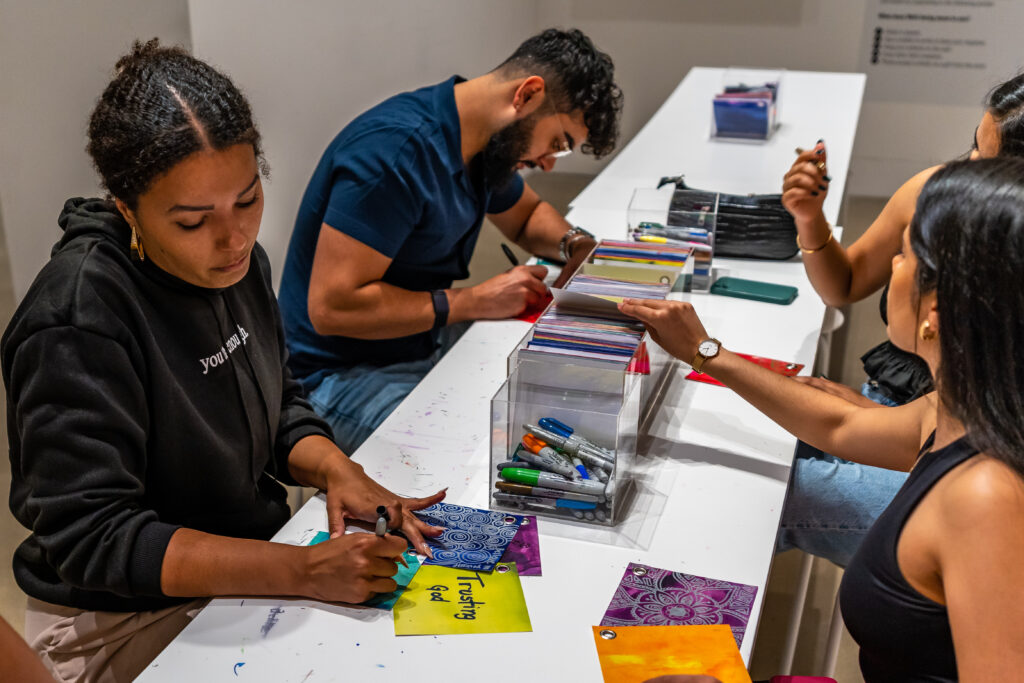
Well-Being Wall participants. Courtesy the artist.
There is a visual cadence and reverberation to Labovitz’s work that feels almost aural, sonic even. The exhibition includes words Labovitz extracted from research and interviews she conducted with healthcare professionals about the connections between art, healing, and well-being. Excerpts from these recordings are featured in the current exhibition. The artist listened deeply to the recordings of each of the interviews as she developed each piece in her WordWorks series. During the live interviews themselves, Labovitz employed a method she calls “relational listening.” For Labovitz, this is a meditative act of connection which she facilitates and it serves as a “conduit, transfiguring human connection into physical forms.”3 Her rigorous qualitative research underlies her practice. In discussing the role of embodied knowing and listening in qualitative research, medical anthropologist Edgar Rivera Colón states, “‘Listening in other words is a primitive act of love, in which a person gives himself to another’s word, making himself accessible and vulnerable to that word.’ When this type of listening—an attending entangled in the suturing dynamics of love—begins via the tools of qualitative research… the world in all its sadness and hope begins anew.”4 Listening, then, is a radical act of tending to, of care, of witness to the “life-worlds and meaning landscapes” of another.5
The WordWorks series features six large-scale 6 by 6-foot square paintings entitled Bearing Witness I-VI. In them, the words of the interviewees are transformed into shape, color, movement, texture. The original word or set of words no longer linguistically or narratively intelligible. They are unmade, remade in an iterative gestural thrust toward meaning. Meaning is a central underlying theme in the exhibition, grounding the concepts of healing, wellness, and creativity that are at the forefront of this body of work. Labovitz draws from the work of Viktor Frankl and his assertion that “striving to find meaning in one’s life is the primary motivational force of man.”6 He developed logotherapy as a philosophical and therapeutic approach grounded in the pursuit of individual meaning and purpose. Frankl highlights creativity as one of three central values which brings meaning to a person’s life. As a writer, I am drawn to Labovitz’s WordWorks series. They render that third space where words fail me, where written and spoken language reaches its ontological limit, and thus a new thing is made. For me, they signal a moment when a thick meaning landscape emerges, a plane that stretches beyond, transcending cartographies of knowing and being. They situate me, hold me in their attentive gestural abstraction and ask of me quite simply and deeply:
Who are you? How are you?
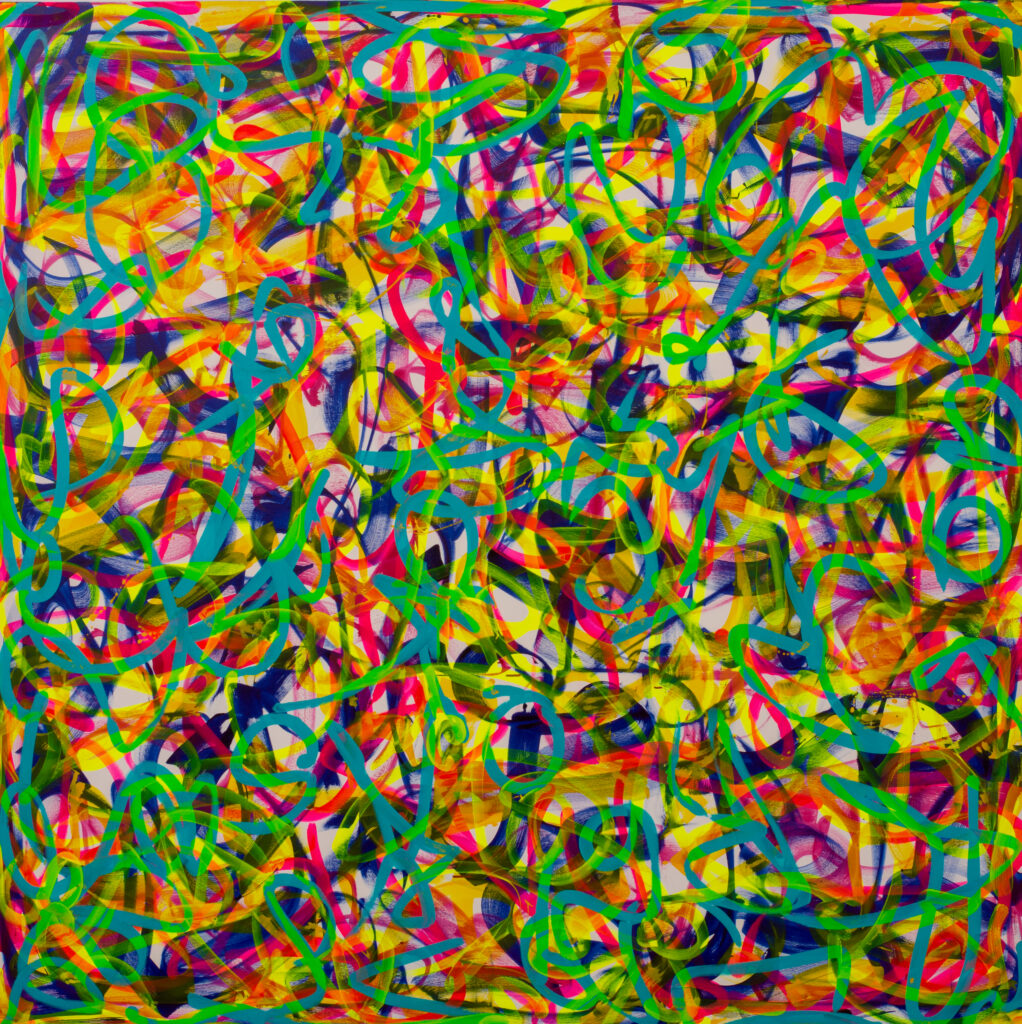
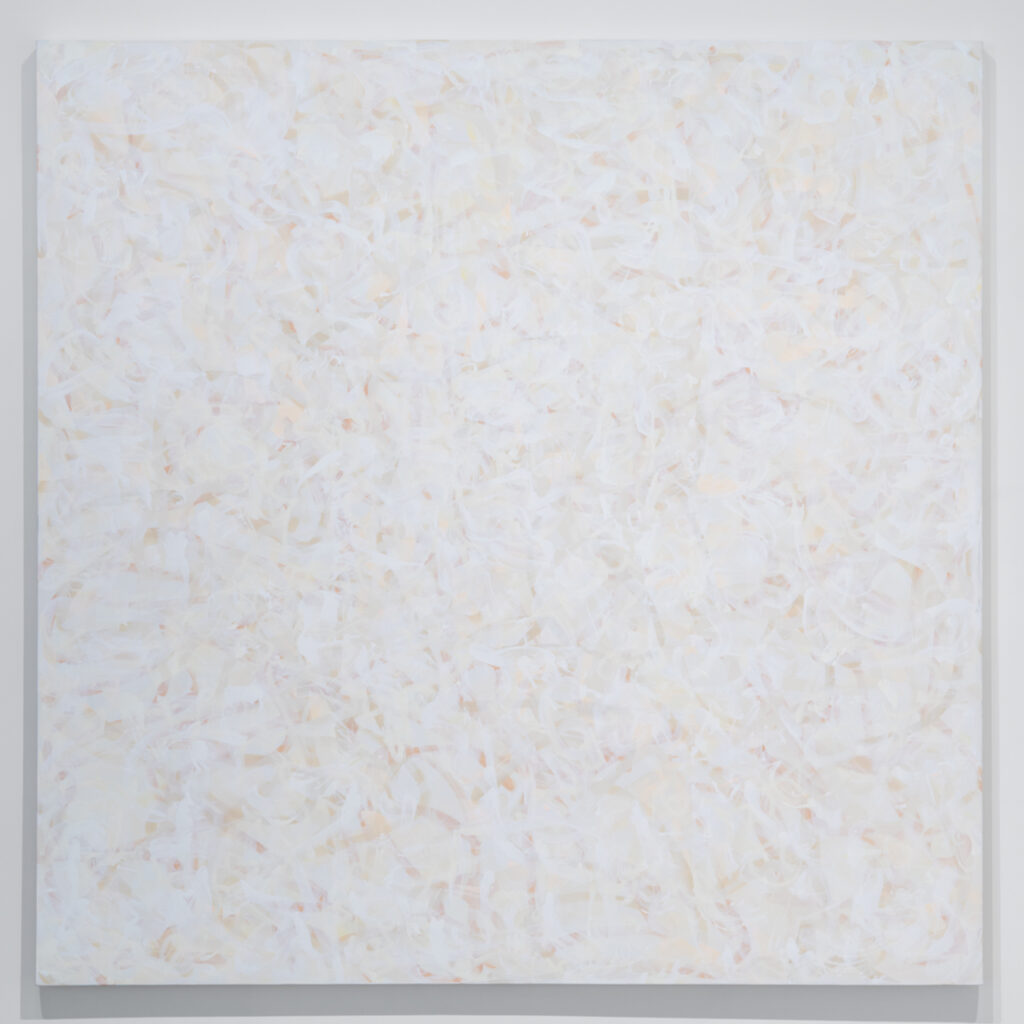
Over the last few years, I have been exploring an ancient writing system developed by my Ejagham ancestors called nsibidi. It is believed to be one of the oldest forms of writing from the African continent. The writing system is at once script, code, symbol, performance. Its forms were traditionally used in actual writing as well as in decorative abstract works on stone, wood, and body adornment. Nsibidi is ultimately about weaving meaning, making meaning. Nigerian artist Victor Ekpuk uses the script to immerse viewers in much the same way I experienced Labovitz’s Bearing Witness I-VI series. Labovitz’s work recalls the ways in which “we do language” as human beings being in this world, which is to say how we do meaning, and ultimately, connection.7 Philosopher Maurice Merleau Ponty described language as “…a life, [language] is our life and the life of the things… language is not a mask over Being, but—if one knows how to grasp it with all its roots and all its folliation—the most valuable witness to Being.”8 Color, light, scale are all part of Labovitz’s vocabulary, the grammar of gesture, texture, and shape all cohere toward an invitation to make meaning and find meaning in our lives.
There is something decidedly alchemical about Labovitz’s work. I have visited the exhibition multiple times now just to experience how it transforms each time and to have it bear witness to my own change. And there can be no change without loss. In their essay “To Give Your Hands to Freedom, First Give Them To Grief” Malkia Devich Cyril concludes that “On either side of change is loss. To reimagine and reshape the world, grief is a skill we need.”9 In a death-denying culture where change is controlled and managed, we are not practiced in the art of holding grief or change. Yet, our individual and collective well-being depends on it.
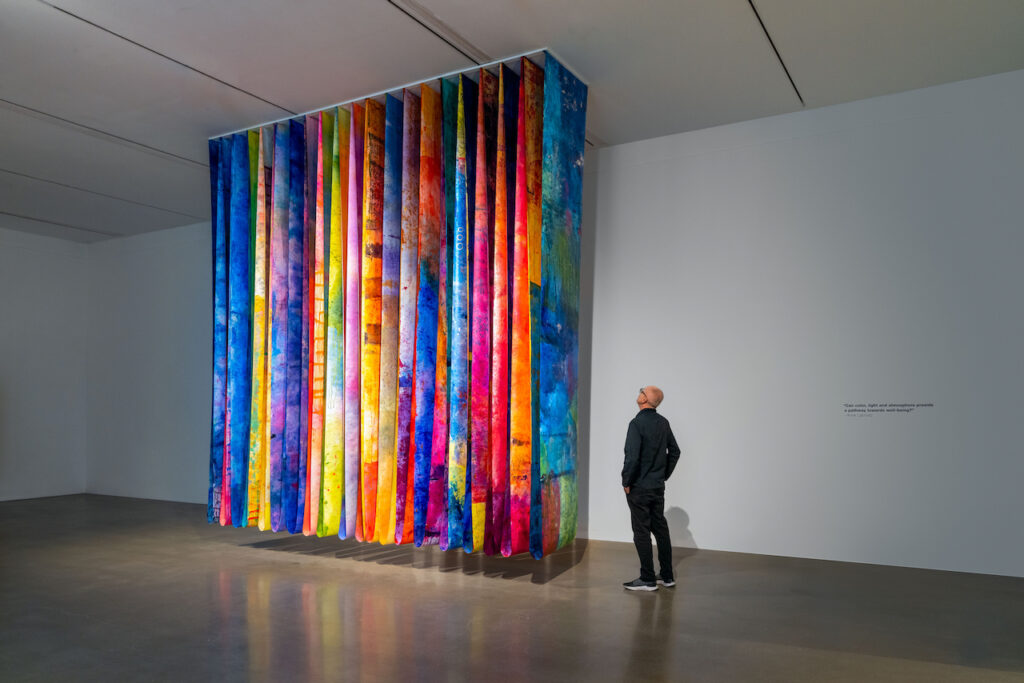
Anne Labovitz, Embracing Well-Being, 2023. Photo: Eric Mueller. 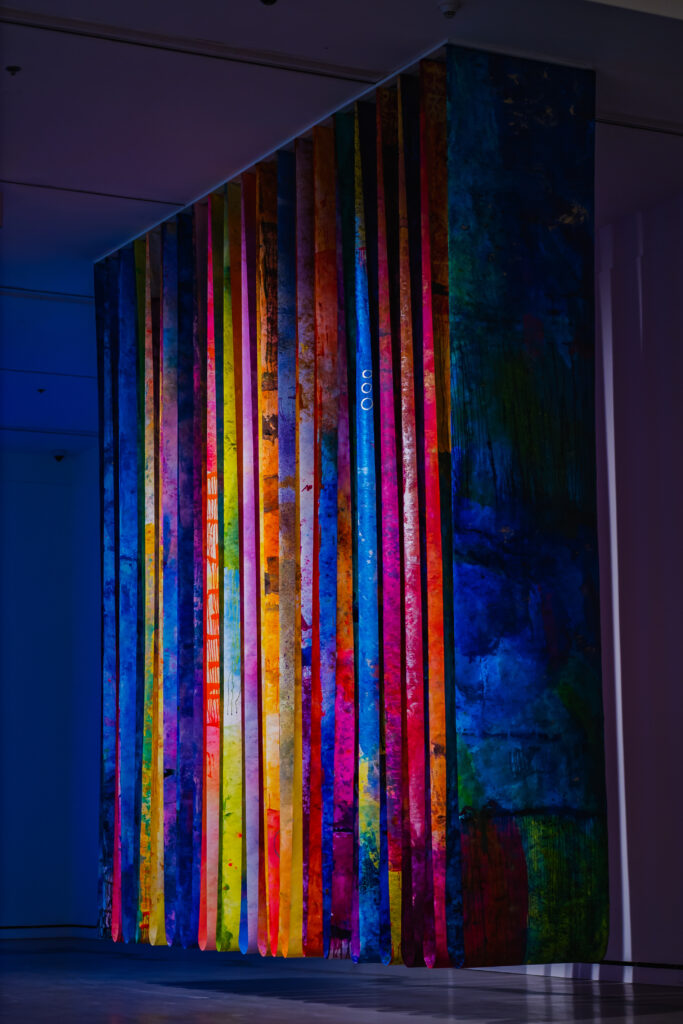
Anne Labovitz, Embracing Well-Being, 2023. Courtesy the artist. 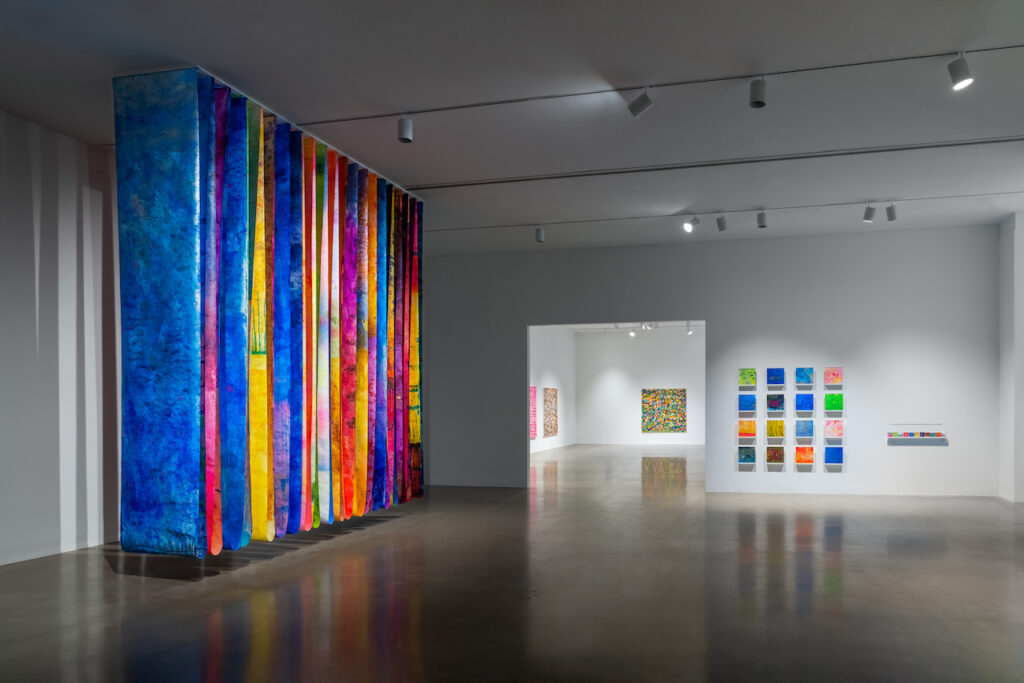
Anne Labovitz, The Nexus of Well-Being and Art, 2023. Photo: Eric Mueller.
There is a language Labovitz’s work speaks that is beyond the textual or even visual. I think there is something here, some connective tissue threading “change” and “language.” But for days, weeks, even I have been unable to articulate it. So I’ll leave it here, knowing that in my meaning landscape they brush up against one another in a way I have still not found written words for. But it reminds me of how the grief I felt on the third floor of the Rochester Art Center that Saturday afternoon was beyond language, and how seismic the shift in my world felt in the wake of so much loss, but also how the gentle, almost imperceptible, sway of Labovitz’s Will to Meaning seemed to understand it, seemed to hold the meaning and magnitude of it all with such reverence and care.
The Nexus of Well-Being and Art by Anne Labovitz is on view at the Rochester Art Center through July 30, 2023. >>more information